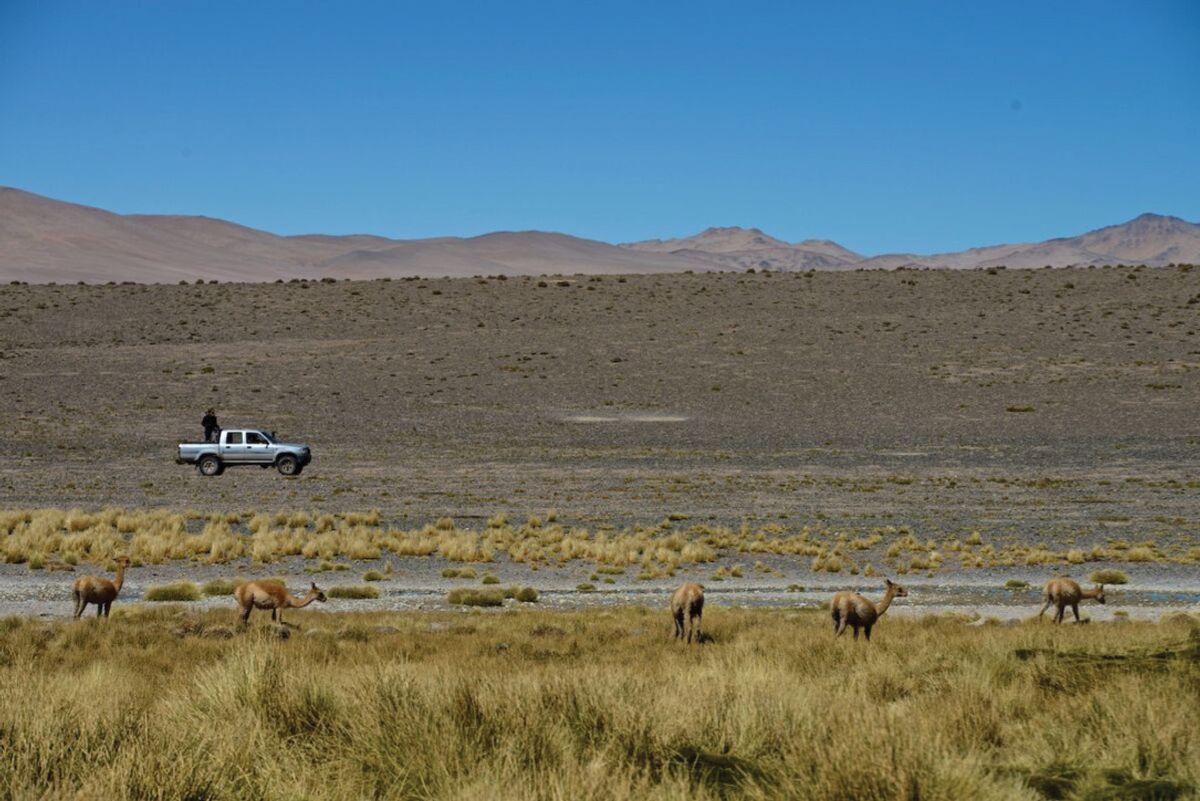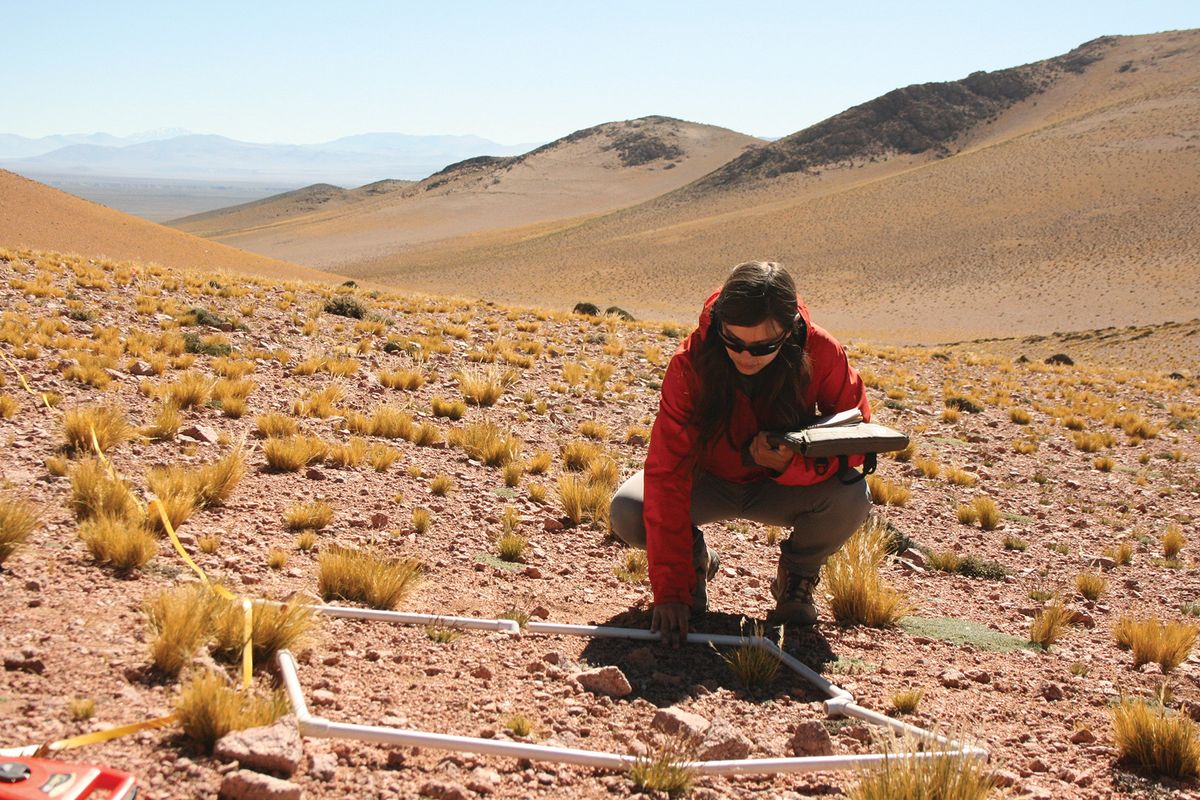ABOVE: Vicuñas (Lama vicugna) run across the plains in San Guillermo National Park, Argentina. JOE RIIS
In March 2020, after a day spent driving and hiking around San Guillermo National Park in Argentina collecting ecological data, Yale University graduate student Julia Monk caught up with global news taking the internet by storm. With the novel coronavirus sweeping the world, Argentina was going to be shutting down flights to the US in a few days. Together with Argentinian researchers also staying at San Guillermo’s field station at the time, “we figured out that things were going to shut down, that [it] was probably a good idea for me to go back to the States,” she recalls.
That was no simple feat. The nearest town was, in good weather, a six-hour drive down a dirt road. From there it was a further three hours to the provincial capital of San Juan, followed by a flight to Buenos Aires. Monk arrived at the capital in the nick of time, catching the last available flight to the US, she says. Her Argentinian colleagues who left the field station at the same time were lucky to make it home too, she adds, as provincial borders within the country soon closed down.
Fortunately, in the two and a half weeks she’d just spent in the park, combined with a three-month trip the previous year, Monk had managed to collect enough data to complete part of her thesis research. She had originally set out to study how the predator-prey relationship between pumas and vicuñas (Vicugna vicugna), a llama-like animal, affects nutrient deposition in the park. But she tacked on another research question after she and her colleagues noticed, beginning in 2015, that a sarcoptic mange epidemic was decimating vicuña populations.
Sarcoptic mange is caused by a mite, Sarcoptes scabiei. The parasite burrows into animals’ skin and lays eggs, which then hatch into larvae that soon molt to become nymphs that can spread mange to other animals. Infected animals can lose clumps of fur and develop itchy skin and callouses, sometimes becoming weak and unable to eat enough to sustain themselves. After the mange took hold—likely spread from domestic llamas at a nearby farm, according to a recent study involving some of Monk’s collaborators—researchers in the park soon noticed mangy-looking vicuñas and a pronounced drop in the animals’ numbers. Before the outbreak, “there were vicuñas everywhere; you saw them all the time. They were kind of as far as the eye could see on the plains,” says Monk. “By our final year of data collection, in 2020, there were just a few family groups that we would see.” Other changes were visible too—for example, grasslands that the vicuñas had previously grazed down to nubby patches were now covered in taller, denser bunches of grass.

Monk and her colleagues realized that the epidemic was an opportunity to study mange’s effects on not just the vicuñas themselves, but the entire ecosystem. For another project, Emiliano Donadío of Fundación Rewilding Argentina and other collaborators of Monk’s had collected data on vegetation coverage at various sites prior to the mange outbreak; they also had tracking information on GPS-tagged pumas (Puma concolor) and Andean condors (Vultur gryphus) that fed in the park. Monk’s role was to gather mange-era data for comparison and analyze any changes that had taken place. To that end, she spent time in San Guillermo driving to the same sites that Donadío’s team had studied and recording factors such as vegetation cover, grass height, and the presence of seed spikes, which indicated that the grasses hadn’t been heavily grazed.
One of the team’s questions was whether the mange was killing vicuñas directly or merely slowing them down so that they became easier prey for pumas, Monk says. Puma-tracking collars revealed that the number of their kills held steady as the vicuñas’ numbers fell steeply, pointing to the former explanation. (The collars were preprogrammed to fall off in 2017, so the researchers don’t know what happened to kill rates after that.) In parallel, Andean condors that once scanned the landscape of San Guillermo for puma kills to scavenge spent more time away from the park after the vicuña population plummeted.

It also turned out that the increased greenness the researchers had observed wasn’t uniform across the park. “Vegetation exploded in the open plains that are where the vicuñas had foraged most heavily in the past,” Monk explains. Those open plains are relatively safe spaces for the animals, as they make it harder for pumas to approach unseen. But in canyons, which provide more cover for pumas, “we actually saw no change in the vegetation after the outbreak of mange,” she says. “It turns out the vicuñas were already so wary in those habitats that they spent less time foraging there and thus, there wasn’t a change when the population crashed.” The results were reported in the May issue of Ecology Letters.

Luis Escobar, a disease ecologist at Virginia Tech who was not involved in the work, applauds the authors for analyzing the far-reaching effects of mange across the ecosystem. The study comes at a time when mange is steadily spreading to new wildlife species and geographic areas worldwide, he says, noting that the new study is the first to report an outbreak of this scale in South American camelids. He adds that the study would have benefited from having a wildlife veterinarian or disease ecologist on the team who could have more definitively identified whether mange was the cause of observed vicuña mortality, or whether other pathogens might also have been circulating at the same time.
Overall, Monk, who expects to graduate next month says, “it was interesting to see how . . . disease can really restructure an ecosystem.” That restructuring, known as a trophic cascade, is more commonly invoked to describe the effects of a predator—most famously, wolves in Yellowstone National Park, which trim elk populations and thus allow the aspen trees that the elk feed on to flourish. Although some previous studies in other systems point to similarly far-reaching effects of pathogens, the “evidence is still pretty thin,” says Julia Buck, a disease ecologist at the University of North Carolina Wilmington who coauthored a 2017 review on the topic but was not involved in Monk’s project. She calls the new paper “a really amazing piece of work” that adds to that evidence. “You wouldn’t think that a tiny little mite would be able to change the whole ecosystem like that,” she says. “But it can.”









